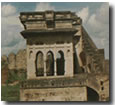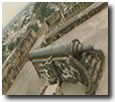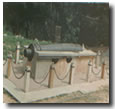 History Jhansi City
History Jhansi City
 |
It
is said that this baradari or pavilion was built
by Raja Gangadhar Rao (A.D. 1838-53) for his brother who
had deep interest in drama, music etc. The pavilion erected
on a platform is square on plan and has three arched openings
on each side. It is beautifully decorated with stucco
mouldings depicting various floral and geometrical patterns.To
the west of the pavilion is a fountain built on the Mughal
Pattern.Believed to be blessed with the power of goddess
Bhawani,this gun is popularly known as Bhawani Shankar.
Placed in north –south orientation, the front portion
of the gun has the form of crocodile, while it has elephant-like
back. It measures 5.00 X0.60m with a diameter of 0.52m.
An inscription on the gun dated to A D 1781 mentions the
gun as Bhawani Shankar. Names of Raja Udit Singh and guru
Jairam are also inscribed. |
 |
This
gun is placed on the eastern side of the fort which can
be seen by entering through the main gate. This lion-headed
gun roared like a lion when fired, hence this name. Operated
by GULAM Gaus Khan, this gun used to frighten the enemies.
It measures 5.50mx1.80m with a diameter of 0.60m.Gulam
Gaus Khan Bux and Motibai were three very faithful military
officers of Rani Laxmi Bai army. Gulam Gaus Khan and Khuda
Bux were artillery experts and there graves are situated
inside the fort near Panch Mahal.Constructed by Raja Bir
Singh Deo, this palace was originally five – storeyed,
Rani Laxmi Bai is said to have used its ground floor as
her meeting-hall, and stayed in one of the apartments
on The first floor. |
 |
The
top floor of the palace was added during the British rule.
During the scientific clearance here, the remain of the
drainage pattern of the palace have come to light.A Squire
platform located in between two bastion on south - east,
is regarded as a place from where the Rani let herself
with Damodar Rao, her adopted son down on her horse on
the night of April fourth and escaped from the fort during
the freedom struggle. Built by Maratha Chief Naru Shankar,
this temple is the exquisite example of blending of Maratha
& Bundella styles of architecture. Rani used to worship
here regularly. The Siva-linga enshrined here
is made of granite stone. Even today,this temple is very
popular among devotees who throng the place in large numbers
during Sivaratri festival. |
 |
Amod Udyan is situated near Siva
Temple in the Fort. It was used by Rani for recreation.Situated
between Amod Bag and Siva temple, this execution tower
was erected during the regime of Raja Gangadarh Rao
for the execution offenders Maratha chief Naru Shankar
extended the fort in north eastern direction in 1742
which came to be known as Shankargrah, largly owing
to construction of Shiv temple in this part. The place
was used for various functions and festival celebrations
in which the Rani along with her friends used to participate.
Rani Mahal, Palace of Rani Laxmi Bai embelished with
multi colored art and painting on its walls and ceilings.
Presently this palace is converted into a museum. It
has a massive collection of Sculptures of the period
between the 9th and 12th Centuries AD. Rani Mahal was
built by Raghunath II of Navalkar family (1769-96) this
palace later converted as the residences of Rani Laxmi
Bai. Architecturally, it is a flat- roofed double-storeyed
building having a quadrangular courtyard with a small
wall and one fountain each on either side.This palace
consists of a number of small rooms, six hall and parallel
corridors with multi-foiled arches. The Darbar hall
approached by a flight of steps is beautifully decorated
with paintings in bright colours. The themes included
floral and faunal designs. The arches are embellished.
with peacock and rosette design. The ground floor of
the palace houses stone sculptures from Lalitpur, Madanpur,
Barua Sagar, Dudhai and Chandpur dating from later Gupta
to medieval period. Maha Laxmi Temple an ancient temple
devoted to Devi Mahalaxmi was built in 18th Century.
This glorious temple is situated outside Laxmi "Darwaza"
at south-western corner of Laxmi Tal. According Dr Vrindawan
Lal Verma Rani Laxmi Bai used to visit this temple on
every tuesday and friday. The Samadhi or 'Chhatari'
of Maharaja Gangadhar Rao is situated on the Laxmi Tal
outside Laxmi Gate. It is situated at a distance of
1.5 Km from the fort. After the death of Maharaja Gangadhar
Rao in 1853, this chhatari or samadhi was built by his
wife Rani Laxmi Bai. The brick-built 'Chhatari' is located
in centre of a courtyard. It is plastered in lime and
decorated with various patterns in stucco. The complex
has two gates-the main one being on south. The main
'Chhatari' stands on a square platform in form of a
baradari consisting of three arched entrances
on each side. The flat roof of baradari is
supported by stone pillars. The panels on upper part
are decorated with various figures-one on the east side
showing perhaps Raja Gangadhar Rao himself.
 |
|
| ..Back |
|
|
|
+ |